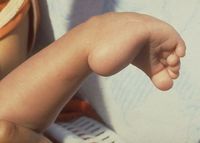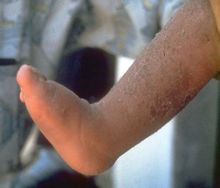Hesperian Health Guides
Club Feet
HealthWiki > Disabled Village Children > Chapter 11: Club Feet, Flat Feet, Bow Legs,and Knock-Knees > Club Feet
 |
| club foot before correction |
About 3 out of 1,000 children are born with a club foot (or feet). Sometimes it runs in the family, but usually the cause is unknown.
Sometimes a newborn baby’s feet turn inward, just because they were in that position in the mother’s womb.
| If the front part of a baby’s foot is turned inward, it will often straighten out by itself before she is 2 years old. |  |
front part only bent back part straight |
 |
To find out whether the condition is likely to correct itself, or if it is a true deformity (club foot) that needs attention, try to put the foot in a standard position.
| Bent foot straightens: TYPICAL |  |
If you can straighten the foot easily, and bend it into a position opposite to the way it was turned, the foot probably does not have a bone deformity and will get better by itself. Also, if you scratch the foot lightly, the child often will move it into a standard position. |
| Bent foot does not straighten: CLUB FOOT |  |
If you cannot put the foot in a standard position, it will need to be straightened with strapping or casts (see Chapter 60). |
Are club feet a sign of some other condition? Although club foot often occurs by itself, it is occasionally a complication of spina bifida (condition in the spinal cord, see Chapter 22). Always check the child’s spine and test if he has feeling in his feet.
The feet may also gradually develop into a club foot position, because of cerebral palsy, polio, arthritis, or spinal cord damage.
Rarely, club feet occur together with a clubbed hand or other weakness and disabilities. See Arthrogryposis.
Contents
Correcting club feet
(For details, see Chapter 60)
 |
 |
 |
 |
| A club foot should be held in a cast; or strapped in a straighter position, soon after birth—until it is corrected past standard position. | After correcting the foot, daily stretching exercises are often needed to help keep the foot straight. | A brace is used (day and night if necessary) to keep the foot from bending in again, | until finally, normal use and exercise keeps the foot straight. |
 |
| club foot after correction with casts, by village workers (PROJIMO) |
About 60% of club feet can be effectively straightened without surgery in 6 to 8 weeks, using either strapping or casts. These methods are described in Chapter 60.
Correction of club feet should begin soon after the child is born—if possible, in the first 2 days. At birth, a baby’s bones and joints are still soft. As the child gets older, his bones get harder and become less flexible.
Usually, good correction without surgery is only possible in the first year of life. If the deformity is not severe, however, a club foot can sometimes be corrected with casts, even if the child is already 2, 3, or even 5 years old or more. But in an older child, it takes longer, and surgery is more often needed for good, lasting results.
Some children will need surgery, even if strapping or casting is done early. However, we have found that some children for whom surgeons have recommended surgery can have their feet straightened with casts at a village center.
Keeping the feet straight once they are corrected
Once a club foot has been straightened, great care must be taken to keep it straight. The whole family must make sure that the following precautions are taken:
- An ankle brace should be worn night and day at least until the child is walking, and often until the child is 15 or 18 years old.

- Foot-stretching exercises will be needed, especially if there is any sign that the foot is clubbing again. Gently and steadily stretch the foot past its typicalposition in the opposite direction of the deformity. Do this exercise 2 or more times a day.
- Check the foot regularly. Return quickly to the rehabilitation center for an evaluation if there is any sign that the clubbing is coming back.
How long will it take?
How difficult it is to straighten a club foot, how long it takes, and how long braces and special exercises will be needed depends on a number of factors:
- The severity of clubbing. A foot with severe clubbing that has affected several bones in the foot is much harder to correct.
- Muscle imbalance, if present, will keep pulling the foot to the inside, even after it is corrected (see muscle testing.)
- Generally, correction is more difficult if both feet are clubbed.
- Club feet in girls (although less common) are likely to be more difficult to correct than in boys.
- If there are any other disabilities (such as a clubbed hand or stiffness in the knees or elbows), club feet may be especially difficult to correct. Usually surgery is needed.
- The older the child, the harder it is to correct a club foot. Past the age of 2 years, it is often not possible without surgery.
- Children without feeling in their feet (spina bifida) require specific precautions and slower correction to avoid pressure sores. Casts, if used, must not apply much pressure, and must be changed often.
If a child’s foot shows little or no improvement after 4 weeks of casting, or if improvement stops in spite of continued casting, surgery is probably needed for more complete correction.
BRACES FOR USE AFTER CORRECTING CLUB FEET
 |
For some feet, a plastic ankle brace may work well. For more difficult feet, a metal brace may be needed, with an ankle strap that pulls the ankle inward. A slight build-up on the outer edge of the sandal or shoe may also help. For instructions on making braces, see Chapter 58. |
 |

For babies under one year, or small children at night, feet can be held in a good position using a bar that joins the 2 feet. For a simple design, see Braces.
| For the child whose feet bend mostly at the middle or front |  |
wearing shoes in reverse may help keep the feet corrected. |  |
||
| left shoe on right foot | right shoe on left foot |


